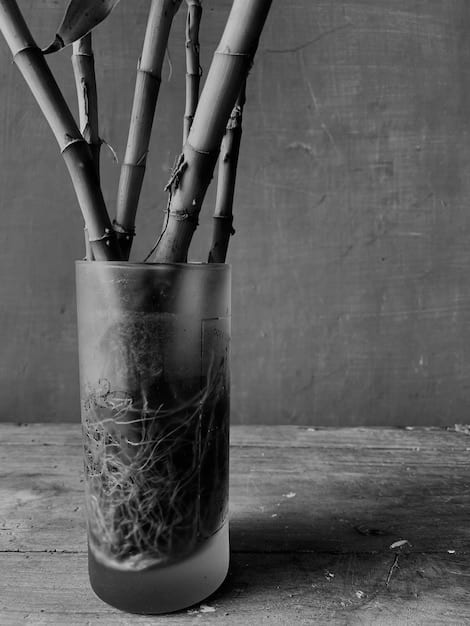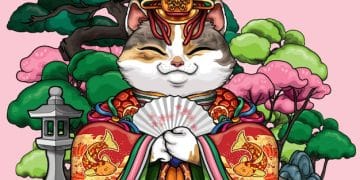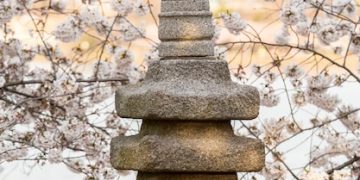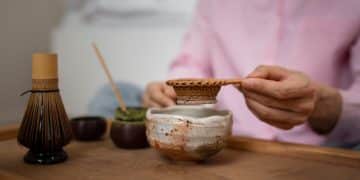Mastering Sumi-e: The Art of Japanese Ink Wash Painting

Sumi-e, the ancient Japanese ink wash painting, is a profound art form emphasizing minimalist brushstrokes to capture the essence of nature, requiring both discipline and a deep understanding of philosophical principles to truly master its intricate yet simple techniques.
Embark on a captivating journey into the serene world of The Art of Sumi-e Painting: Mastering the Techniques of Japanese Ink Wash Painting. This evocative art form, deeply rooted in Japanese aesthetics and philosophy, offers more than just visual beauty; it provides a meditative pathway to express the raw essence of nature with simplicity and profound feeling. Discover how masterful brushwork transforms humble ink into breathtaking landscapes and evocative figures, capturing the spirit rather than mere replication.
The Philosophical Roots of Sumi-e and Its Historical Journey
Sumi-e, often translated as “ink painting,” is far more than just a technique; it is a philosophy embedded in art. Its origins can be traced back to Tang Dynasty China (618-907 AD), where it emerged as “sumi-e-ga” (ink painting) and was heavily influenced by Zen Buddhism. Monks brought this art form to Japan during the Kamakura period (1185-1333), where it was embraced and refined, evolving into the distinct Japanese style we recognize today.
The philosophical underpinnings of Sumi-e are crucial to truly appreciating and practicing this art. It’s not about meticulous detail or photographic realism, but about capturing the “qi” or life force, the inner spirit of the subject. This involves simplifying forms, embracing asymmetry, and utilizing empty space (ma) as an active component of the composition, rather than a void. The aim is to express the spiritual harmony between humanity and nature.
Early Influences and Evolution
In its formative years in Japan, Sumi-e was primarily practiced by Zen monks. Their austere lifestyle and meditative practices found a perfect artistic outlet in Sumi-e’s disciplined and minimalist approach. The act of painting became a form of meditation, a way to achieve enlightenment through focus and concentration. This spiritual connection is evident in the themes often depicted in early Sumi-e works, such as tranquil landscapes, solitary figures, and symbolic representations of elements like bamboo and plum blossoms.
- Zen Buddhism: Provided the philosophical framework, emphasizing simplicity and enlightenment.
- Song Dynasty Art: Directly influenced the early technical and compositional styles.
- Muromachi Period: Saw the flourishing of Sumi-e as a distinct Japanese art form, moving beyond monastic circles.
As Sumi-e evolved, it moved beyond the exclusive domain of monasteries and gained popularity among the samurai class and aristocracy. Artists like Sesshū Tōyō became masters, synthesizing Chinese and Japanese aesthetics to create unique and powerful works. His travels to China allowed him to study firsthand the techniques and philosophies, further enriching the Japanese Sumi-e tradition upon his return.
The journey of Sumi-e from a monastic practice to a revered art form illustrates its adaptability and enduring appeal. It’s a testament to its ability to convey profound meaning through the most basic of materials: ink, water, and paper. This historical perspective provides a vital context for understanding the techniques and principles that govern this beautiful art.

Essential Tools and Materials for the Sumi-e Artist
Mastering Sumi-e begins with understanding and selecting the right tools, collectively known as the “Four Treasures of the Study” (文房四宝, bumbō shihō). These core materials are not merely instruments; they are extensions of the artist’s will and spirit, each playing a critical role in bringing a painting to life.
The Four Treasures and Beyond
The fundamental tools for Sumi-e are the inkstick (sumi), the ink stone (suzuri), the brush (fude), and paper (washi). Each requires careful selection and understanding to achieve the desired effects.
- Inkstick (Sumi): Traditional sumi is made from pine soot or oil soot mixed with animal glue and fragrance. Different inks produce varying shades and textures. Good quality ink provides rich blacks and subtle grays. Grinding the inkstick is a meditative practice in itself, allowing the artist to connect with the material.
- Ink Stone (Suzuri): Used to grind the inkstick with water to create the liquid ink. The surface of the suzuri must be smooth but with enough texture to effectively break down the inkstick particles. A good suzuri will retain water and allow for a gradual release of ink.
- Brush (Fude): Sumi-e brushes are typically made from animal hairs such as wolf, goat, deer, or badger, or a combination. Artists often possess a variety of brushes, each suited for different strokes and effects. The brush tip is crucial for achieving delicate lines and broad washes.
- Paper (Washi): Traditional Sumi-e paper, called washi, is made from natural fibers like mulberry, bamboo, or rice. Washi varies in absorbency and texture, which significantly impacts how the ink spreads and dries. Choosing the right paper for a specific subject or technique is vital for success.
Beyond these four, a few other items are essential. A water dropper (mizusashi) is used to add precise amounts of water to the ink stone. A felt mat (shitajiki) protects the work surface and provides a stable, absorbent base for the paper. Paperweights (bunchin) help keep the paper flat during the painting process. These seemingly simple tools are central to the meditative and precise nature of Sumi-e, allowing for focus on the gesture and flow of the brush.
Understanding the properties of these materials is crucial. For instance, the water content in your ink dictates the luminosity and depth of your strokes. A drier brush with thicker ink produces crisp, textured lines, while a wetter, diluted ink creates soft, flowing washes. The absorbency of the washi paper also plays a significant role, as it dictates how quickly the ink spreads and how the tonal variations are expressed. This intimate knowledge of materials is what distinguishes a skilled Sumi-e artist, enabling them to achieve a profound range of artistic expression with minimal means.
Mastering the Fundamental Brushstrokes and Techniques
The essence of Sumi-e lies in its minimalist approach, where every brushstroke carries significant meaning. Mastering the fundamental strokes is paramount, as they form the lexicon of this visual language. These techniques are less about strict replication and more about conveying the spirit, texture, and movement of the subject.
Controlling the Brush and Ink
At the heart of Sumi-e technique is the concept of “living lines” (生きた線, ikita sen). This refers to lines that are vibrant, expressive, and imbued with energy. Achieving this requires meticulous control over the brush, ink, and water.
- The Four Gentlemen (四君子, Shikunshi): These are symbolic subjects—bamboo, orchid, plum blossom, and chrysanthemum—that serve as foundational exercises. They help artists learn different brush handling techniques, control of ink tones, and composition. Bamboo, for example, teaches the strength and flexibility of strokes, while the orchid emphasizes delicate lines and varied ink washes.
- Tonal Variations (墨色, bokushoku): Sumi-e utilizes various shades of ink, from the deepest black (nōboku) to the palest gray (tanboku). Achieving these tones, often within a single stroke, is a hallmark of mastery. This is done by varying the amount of water mixed with the ink, and by loading the brush with different concentrations of ink to create graded washes.
- “Empty Space” (間, Ma): Just as crucial as the painted forms is the unpainted space. Ma is not merely negative space; it is an active component that defines and enhances the painted forms, suggesting distance, emptiness, and atmosphere. Learning to use ma effectively is a sign of advanced Sumi-e technique.
The practice of Sumi-e involves a journey from simple strokes to complex compositions, all building upon a foundation of controlled motion and conscious breathing. It’s often said that true mastery is not about painting a perfect form, but about the artist’s ability to imbue the form with life and emotion using minimal strokes. The brush becomes a conduit for the artist’s inner state, reflecting their discipline and spiritual connection to the subject.
Through countless hours of practice, an artist develops a refined sense of touch and intuition, allowing them to create spontaneous, yet deliberate, marks. This cultivation of technique is not just physical; it’s a mental discipline that fosters presence and mindfulness. Each stroke is a singular, unrepeatable moment, demanding full attention and intent. The understanding of how ink flows on paper, how the pressure on the brush affects the line, and how to balance dark and light tones becomes second nature, allowing for fluid and expressive creation.
Capturing Nature’s Essence: Common Subjects and Symbolism in Sumi-e
Sumi-e is intimately connected with nature, and its subjects often serve as vehicles for conveying deeper philosophical meanings. The selection of themes is rarely arbitrary; instead, each subject carries a rich tapestry of symbolism, reflecting the virtues, seasons, and cycles of life.
Symbolic Depictions and Their Meanings
The “Four Gentlemen” are perhaps the most iconic subjects in Sumi-e, not only as practice exercises but as symbolic representations of human virtues and natural conditions.
- Bamboo (竹, Take): Symbolizes resilience, uprightness, and humility. Its ability to bend without breaking in the wind represents strength in adversity, while its hollow stem signifies emptiness and open-mindedness.
- Orchid (蘭, Ran): Represents purity, elegance, and nobility. It blooms in secluded places, signifying a recluse of high moral character. The delicate lines used to depict orchids convey grace and subtlety.
- Plum Blossom (梅, Ume): A symbol of perseverance and hope, as it blooms in late winter, defying the cold. It signifies renewal, courage, and beauty in challenging circumstances. Its branches often appear gnarled, contrasting with delicate blossoms, much like life’s journey.
- Chrysanthemum (菊, Kiku): Represents longevity, nobility, and autumn’s beauty. It often symbolizes enduring friendships and warmth, making it a popular subject for its intricate petals and gentle curves.
Beyond the Four Gentlemen, a myriad of natural subjects populate the Sumi-e world, each chosen for its inherent beauty and symbolic resonance. Mountains, water, birds, and fish are frequently depicted, embodying universal principles and natural harmony. Mountains often symbolize stability, grandeur, and the spiritual quest, while water represents fluidity, change, and the passage of time. The interplay between these elements creates dynamic compositions that evoke a sense of balance and unity.
Artists use these subjects not merely to reproduce their appearance but to interpret their inner spirit, sometimes through personification. A lone bird on a branch might embody solitude, or a flowing waterfall might reflect unceasing movement. The artist’s interpretation and ability to infuse their own feeling into these timeless symbols is what gives each Sumi-e painting its unique character and depth. This approach encourages viewers to look beyond the surface and engage with the deeper narrative within the strokes, transforming a simple rendering into a profound statement.
Integrating Mindfulness and Meditation into Sumi-e Practice
Sumi-e is often described as “Zen painting,” a testament to its deep connection with mindfulness and meditative practices. The act of creation is not merely a technical exercise but a spiritual discipline, fostering concentration, intuition, and a profound sense of presence. This integration enhances both the artistic output and the personal well-being of the artist.
The Meditative Flow of Brush and Mind
Before even touching the brush to paper, the Sumi-e artist engages in a ritual that is inherently meditative. Grinding the ink, a slow and deliberate process, serves as a transition from the mundane world to the artistic space. This rhythmic action helps to quiet the mind, focus attention, and prepare the artist for the creative flow. It’s an opportunity to center oneself, similar to the initial steps in a meditation practice. The aroma of the ink further enhances this sensory experience, deepening the immersion.
- One-Stroke Painting (一筆画, Ippitsu-ga): Many Sumi-e masters strive for “one-stroke painting,” where an entire composition or a significant part of it is completed with a single, continuous brushstroke. This technique demands extreme focus, precision, and spontaneity, leaving no room for hesitation or correction, mirroring the essence of mindfulness in action.
- Breathing and Posture: Proper posture and controlled breathing are integral. A relaxed but upright posture and deep, steady breathing help stabilize the body and mind, allowing for fluid and uninterrupted brush movements. The breath becomes synchronized with the stroke, ensuring a continuous flow of conscious energy into the art.
During the painting process, the artist enters a state of flow, where external distractions fade, and the mind becomes fully absorbed in the present moment. This is where the principles of Zen come alive through the brush. Each stroke is a deliberate act, yet executed with spontaneity (無為, mu-i, “non-action” or “effortless action”). The artist cultivates a mind free from judgment, embracing imperfections as part of the natural process, similar to how one observes thoughts without attachment in meditation.
The practice extends beyond the canvas itself. Reflecting on one’s finished work, or even an imperfect stroke, offers insights into one’s mental state during creation. The ink’s nuances, the strength of a line, or the flow of a wash can reveal the artist’s focus, patience, or even their inner turmoil. This reflective process becomes a feedback loop, continually refining not just the artistic technique, but also the artist’s self-awareness and meditative discipline. Thus, Sumi-e transcends art; it becomes a path to greater mindfulness and inner harmony.

Contemporary Sumi-e: Bridging Tradition and Modernity
While Sumi-e is deeply rooted in ancient traditions, it is far from being a stagnant art form. Contemporary Sumi-e artists are exploring new frontiers, pushing the boundaries of traditional techniques while honoring the philosophical essence that defines it. This evolution brings a fresh perspective to an age-old practice, ensuring its relevance in the modern world.
Innovation and New Interpretations
One of the most exciting aspects of contemporary Sumi-e is its diversification in subject matter and stylistic approaches. While traditional themes like bamboo and plum blossoms remain popular, artists are now depicting urban landscapes, abstract forms, and even social commentary through the medium of ink wash.
- Abstract Sumi-e: Some artists utilize the fluidity and tonal range of ink to create purely abstract compositions, focusing on texture, movement, and the interplay of light and shadow rather than recognizable forms. This modern approach retains the spontaneity and meditative quality of traditional Sumi-e while offering a new visual language.
- Mixed Media: While purists adhere strictly to ink on paper, some contemporary artists are experimenting with incorporating other media, such as color, collage, or digital elements, to add new dimensions to their Sumi-e works. This fusion creates intriguing contrasts and expands the expressive possibilities.
- Global Reach: Sumi-e is no longer confined to Japan or East Asia. Artists around the globe are embracing its principles, adapting them to their own cultural contexts and personal experiences. This global adoption introduces diverse interpretations and enriches the art form with new perspectives.
Technological advancements also play a subtle role. While the fundamental tools remain the same, access to high-quality materials and online learning resources has democratized the practice, making it accessible to a wider audience. Artists can now share their work and learn from masters across continents, fostering a vibrant global community of Sumi-e practitioners.
Despite these innovations, the core tenets of Sumi-e—the emphasis on simplicity, the mastery of brush and ink, the use of empty space, and the spiritual connection to nature—remain central. Contemporary artists often spend years mastering traditional techniques before venturing into more experimental territory. This foundational understanding ensures that their modern interpretations are informed by a deep respect for the art’s heritage. Thus, contemporary Sumi-e is not about abandoning tradition but about expanding its canvas, demonstrating the timeless versatility and enduring appeal of this exquisite Japanese art form.
Developing Your Own Sumi-e Practice: Tips for Aspiring Artists
Embarking on your Sumi-e journey is a deeply personal and rewarding experience. While it requires discipline and patience, the path to mastering Japanese ink wash painting is accessible to anyone willing to embrace its unique philosophy and techniques. Here are some practical tips to help aspiring artists cultivate their own practice.
Getting Started and Sustaining Momentum
The first step is to gather your basic tools. You don’t need the most expensive materials to start, but good quality ink, brushes, and paper will make a significant difference in your learning experience. Investing in a starter set often provides a good balance of quality and affordability.
- Start with the Four Gentlemen: As mentioned earlier, focusing on bamboo, orchid, plum blossom, and chrysanthemum is an excellent way to build foundational skills. There are numerous instructional books and online tutorials dedicated to these subjects. They teach essential brush control, tonal variations, and compositional principles.
- Practice Daily: Consistency is key in Sumi-e. Even short, daily practice sessions of 15-30 minutes can yield significant progress. Repetition helps build muscle memory and refines your control over the brush. Think of it as a daily meditation.
- Embrace Imperfection: Sumi-e celebrates spontaneity and the natural flow of ink. Don’t strive for perfection in every stroke. Instead, learn from your mistakes and appreciate the unique qualities of each mark. The journey of learning is as important as the destination.
- Study Masterpieces: Observe the works of renowned Sumi-e masters, both historical and contemporary. Analyze their brushwork, compositions, and use of empty space. Don’t try to copy them directly, but draw inspiration and understand the underlying principles informing their art. Many museums offer online collections for virtual viewing.
Beyond the technical aspects, developing your Sumi-e practice also involves cultivating a mindset of patience and observation. Spend time observing nature, not just its forms, but its rhythms, movements, and inherent spirit. This deeper observation will inform your brushstrokes and allow you to capture the essence of your subjects. Consider drawing inspiration from your immediate surroundings—a leaf, a stone, the way light falls on a simple object.
Finally, seek guidance from experienced teachers or join an online community. Constructive feedback can accelerate your learning, and sharing your journey with others provides motivation and new perspectives. Sumi-e is a lifelong journey of learning and discovery, and each stroke you make brings you closer to a deeper understanding of art, nature, and yourself. Allow the process to unfold naturally, and enjoy the meditative tranquility that accompanies each brushstroke, transforming a simple act of painting into a profound personal exploration.
| Key Aspect | Brief Description |
|---|---|
| 🧘 Philosophy | Rooted in Zen Buddhism, Sumi-e emphasizes capturing the spirit (qi) and essence of subjects, not just their appearance, within a minimalist framework. |
| 🖌️ Essential Tools | Requires the “Four Treasures”: inkstick, ink stone, brush, and washi paper, each vital for specific effects and integral to the meditative process. |
| 🌟 Core Techniques | Focuses on mastering “living lines,” tonal variations, and effective use of “empty space” (ma) through rigorous practice, often starting with the Four Gentlemen. |
| 🌿 Subjects & Symbolism | Commonly depicts natural elements like bamboo, orchids, and mountains, each carrying deep symbolic meaning and reflecting virtues or natural cycles. |
Frequently Asked Questions About Sumi-e Painting
Sumi-e fundamentally differs from Western painting in its philosophical approach and use of materials. Western art often focuses on realism, color, and texture to render an accurate depiction of a subject. Sumi-e, in contrast, emphasizes capturing the essence or spirit of a subject through minimalist brushstrokes, relying solely on black ink and water to create a wide range of tones and evoking profound emotional depth through simplicity and strategic use of empty space.
Yes, Sumi-e painters typically use various types of brushes, each designed for specific effects. Brushes are often made from different animal hairs, such as wolf, goat, or a blend, and vary in stiffness and tip shape. Long-tipped, soft brushes are ideal for graceful, flowing lines and washes, while stiffer, shorter-tipped brushes are used for more precise, textured strokes, allowing artists to achieve a broad spectrum of expressions.
“Empty space,” known as “ma,” is a crucial and active element in Sumi-e, not merely a void. It provides balance, depth, and atmosphere to the composition, allowing the viewer’s imagination to fill in what is unpainted. Ma enhances the impact of the painted elements, suggesting distances, mist, or air, and often represents the philosophical concept of interconnectedness and the unseen spiritual dimensions of a scene.
Absolutely, beginners can definitely learn Sumi-e even without prior art experience. The emphasis on repetitive practice, particularly with the “Four Gentlemen” (bamboo, orchid, plum blossom, and chrysanthemum), provides a structured and meditative learning path. Accessibility of materials and online resources makes starting easier, welcoming individuals who are drawn to its minimalist philosophy and meditative aspects, regardless of their artistic background.
Ink grinding in Sumi-e is a meditative and integral part of the artistic process. Using an inkstick and ink stone with water, artists manually grind the ink, which allows them to control the consistency and tone of the ink, from rich blacks to subtle grays. This preparation ritual helps to quiet the mind, focus attention, and connect the artist to the materials, setting the stage for the mindful creation of the artwork.
Conclusion
The journey into The Art of Sumi-e Painting: Mastering the Techniques of Japanese Ink Wash Painting is a testament to the enduring power of simplicity and the profound connection between art, nature, and spiritual practice. From its Zen Buddhist origins to its contemporary interpretations, Sumi-e transcends mere artistic expression, offering a pathway to mindfulness and a deeper appreciation for the essence of forms. By embracing its philosophy, understanding its tools, and diligently practicing its techniques, aspiring artists can embark on a rich and rewarding creative voyage, where each brushstroke becomes a meditative act, and every minimalist composition speaks volumes about life’s subtle beauty.





